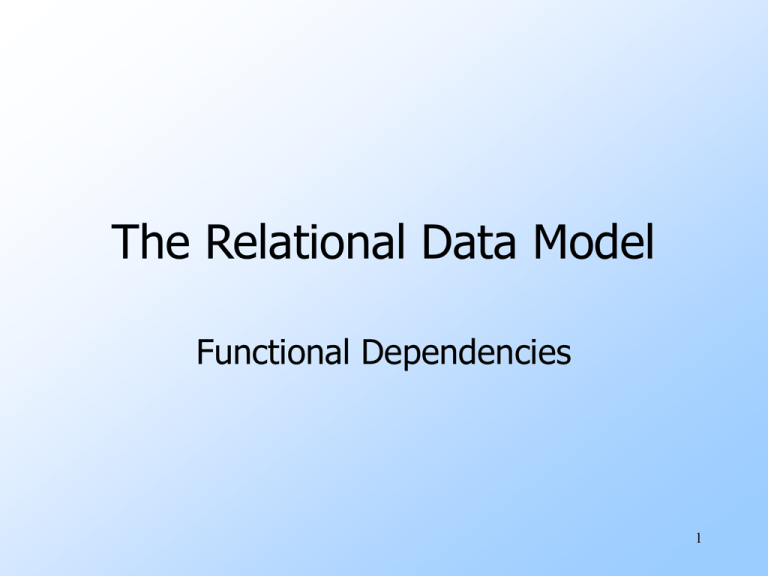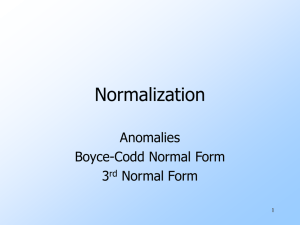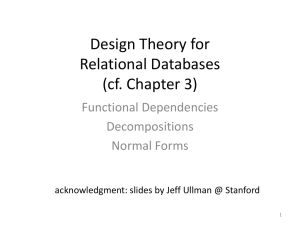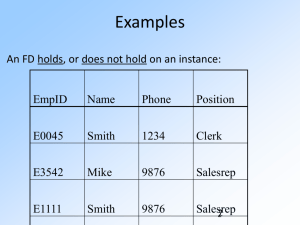The Relational Data Model Functional Dependencies 1
advertisement

The Relational Data Model
Functional Dependencies
1
Functional Dependencies
X -> A is an assertion about a relation R that
whenever two tuples of R agree on all the
attributes of X, then they must also agree on
the attribute A.
Say “X -> A holds in R.”
Notice convention: …,X, Y, Z represent sets of
attributes; A, B, C,… represent single attributes.
Convention: no set formers in sets of attributes,
just ABC, rather than {A,B,C }.
2
Example
Drinkers(name, addr, beersLiked,
manf, favBeer).
Reasonable FD’s to assert:
1. name -> addr
2. name -> favBeer
3. beersLiked -> manf
3
Example Data
name
Janeway
Janeway
Spock
addr
Voyager
Voyager
Enterprise
Because name -> addr
beersLiked
Bud
WickedAle
Bud
manf
A.B.
Pete’s
A.B.
favBeer
WickedAle
WickedAle
Bud
Because name -> favBeer
Because beersLiked -> manf
4
FD’s With Multiple Attributes
No need for FD’s with > 1 attribute on
right.
But sometimes convenient to combine FD’s
as a shorthand.
Example: name -> addr and name ->
favBeer become name -> addr favBeer
> 1 attribute on left may be essential.
Example: bar beer -> price
5
Keys of Relations
K is a key for relation R if:
1. Set K functionally determines all attributes of R
2. For no proper subset of K is (1) true.
If K satisfies (1), but perhaps not (2), then
K is a superkey.
Note E/R keys have no requirement for
minimality, as in (2) for relational keys.
6
Example
Consider relation Drinkers(name, addr,
beersLiked, manf, favBeer).
{name, beersLiked} is a superkey
because together these attributes
determine all the other attributes.
name -> addr favBeer
beersLiked -> manf
7
Example, Cont.
{name, beersLiked} is a key because
neither {name} nor {beersLiked} is a
superkey.
name doesn’t -> manf; beersLiked doesn’t
-> addr.
In this example, there are no other
keys, but lots of superkeys.
Any superset of {name, beersLiked}.
8
E/R and Relational Keys
Keys in E/R are properties of entities
Keys in relations are properties of tuples.
Usually, one tuple corresponds to one entity,
so the ideas are the same.
But --- in poor relational designs, one entity
can become several tuples, so E/R keys and
Relational keys are different.
9
Example Data
name
Janeway
Janeway
Spock
addr
Voyager
Voyager
Enterprise
beersLiked
Bud
WickedAle
Bud
manf
A.B.
Pete’s
A.B.
favBeer
WickedAle
WickedAle
Bud
Relational key = name beersLiked
But in E/R, name is a key for Drinkers, and beersLiked is a key
for Beers.
Note: 2 tuples for Janeway entity and 2 tuples for Bud entity.
10
Where Do Keys Come From?
1. We could simply assert a key K. Then
the only FD’s are K -> A for all
atributes A, and K turns out to be the
only key obtainable from the FD’s.
2. We could assert FD’s and deduce the
keys by systematic exploration.
E/R gives us FD’s from entity-set keys
and many-one relationships.
11
FD’s From “Physics”
While most FD’s come from E/R
keyness and many-one relationships,
some are really physical laws.
Example: “no two courses can meet in
the same room at the same time” tells
us: hour room -> course.
12
Inferring FD’s: Motivation
In order to design relation schemas
well, we often need to tell what FD’s
hold in a relation.
We are given FD’s X1 -> A1, X2 -> A2,…,
Xn -> An , and we want to know
whether an FD Y -> B must hold in any
relation that satisfies the given FD’s.
Example: If A -> B and B -> C hold, surely
A -> C holds, even if we don’t say so.
13
Inference Test
To test if Y -> B, start assuming two tuples
agree in all attributes of Y.
Use the given FD’s to infer that these tuples
must also agree in certain other attributes.
If B is eventually found to be one of these
attributes, then Y -> B is true; otherwise, the
two tuples, with any forced equalities form a
two-tuple relation that proves Y -> B does
not follow from the given FD’s.
14
Closure Test
An easier way to test is to compute the
closure of Y, denoted Y +.
Basis: Y + = Y.
Induction: Look for an FD’s left side X
that is a subset of the current Y +. If
the FD is X -> A, add A to Y +.
15
X
Y+
A
new Y+
16
Finding All Implied FD’s
Motivation: “normalization,” the process
where we break a relation schema into
two or more schemas.
Example: ABCD with FD’s AB ->C,
C ->D, and D ->A.
Decompose into ABC, AD. What FD’s hold in
ABC ?
Not only AB ->C, but also C ->A !
17
Basic Idea
To know what FD’s hold in a projection,
we start with given FD’s and find all
FD’s that follow from given ones.
Then, restrict to those FD’s that involve
only attributes of the projected schema.
18
Simple, Exponential Algorithm
1. For each set of attributes X, compute
X +.
2. Add X ->A for all A in X + - X.
3. However, drop XY ->A whenever we
discover X ->A.
Because XY ->A follows from X ->A.
4. Finally, use only FD’s involving
projected attributes.
19
A Few Tricks
Never need to compute the closure of
the empty set or of the set of all
attributes.
If we find X + = all attributes, don’t
bother computing the closure of any
supersets of X.
20
Example
ABC with FD’s A ->B and B ->C.
Project onto AC.
A +=ABC ; yields A ->B, A ->C.
• We do not need to compute AB
+
or AC +.
B +=BC ; yields B ->C.
C +=C ; yields nothing.
BC +=BC ; yields nothing.
21
Example, Continued
Resulting FD’s: A ->B, A ->C, and
B ->C.
Projection onto AC : A ->C.
Only FD that involves a subset of {A,C }.
22
A Geometric View of FD’s
Imagine the set of all instances of a
particular relation.
That is, all finite sets of tuples that
have the proper number of
components.
Each instance is a point in this space.
23
Example: R(A,B)
{(1,2), (3,4)}
{}
{(5,1)}
{(1,2), (3,4), (1,3)}
24
An FD is a Subset of Instances
For each FD X -> A there is a subset
of all instances that satisfy the FD.
We can represent an FD by a region in
the space.
Trivial FD : an FD that is represented
by the entire space.
Example: A -> A.
25
Example: A -> B for R(A,B)
{(1,2), (3,4)}
A -> B
{}
{(5,1)}
{(1,2), (3,4), (1,3)}
26
Representing Sets of FD’s
If each FD is a set of relation instances,
then a collection of FD’s corresponds to
the intersection of those sets.
Intersection = all instances that satisfy all
of the FD’s.
27
Example
Instances satisfying
A->B, B->C, and
CD->A
A->B
B->C
CD->A
28
Implication of FD’s
If an FD Y -> B follows from FD’s
X1 -> A1,…, Xn -> An , then the region in
the space of instances for Y -> B must
include the intersection of the regions
for the FD’s Xi -> Ai .
That is, every instance satisfying all the
FD’s Xi -> Ai surely satisfies Y -> B.
But an instance could satisfy Y -> B, yet
not be in this intersection.
29
Example
A->B A->C B->C
30





